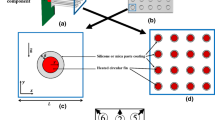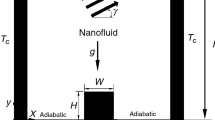Abstract
The aim of this research is to investigate numerically the efficiency of employing CNT–water/ethylene glycol nanofluid into an inclined square box heat dissipator featured with L-shaped fins beneath the impact of Lorentz powers, taking into consideration the nanoliquid’s radiative effect. The study is constructed using the Comsol Multiphysics tool. The effects of Rayleigh number (\(10^{3} \le\) Ra \(\le 10^{6}\)), Hartmann number (0 \(\le\) Ha \(\le\) 40), the radiative emitting coefficient (0 \(\le R_{d} \le\) 2), the length (0.4 \(\le\) L \(\le\) 0.7) and width (0.01 \(\le \delta \le\) 0.07) of L-shaped fins, the heat dissipator box inclination (\(0^{^\circ } \le \gamma \le 90^{^\circ }\)) and the L-shaped fins dispositions are all analyzed as variables that affect the heat waste proficiency. A comparison between classical and L-shaped fins is confirmed. The data reveal that expanding the amount of Rayleigh and also the radiative element enhances convection cooling rate. Whenever radiative emission is maintained, the action of Lorentz strengths on slowing the convection cooling rate is mitigated. Furthermore, heightening both the L-shaped fins length and width enhances more the convection cooling proficiency excluding the L = 0.4 and \(\delta\) = 0.07 scenario. Relying on the chamber slant angle, manifold scenarios are unearthed in terms of the excellent L-shaped fins disposition. The L-shaped fins dissipate heat more effectively than classical one.


















Similar content being viewed by others
Data availability
Data are available on request from the authors.
Change history
22 August 2022
A Correction to this paper has been published: https://doi.org/10.1140/epjp/s13360-022-03126-3
Abbreviations
- \(B_{0}\) :
-
Magnetic field intensity (T)
- Cp :
-
Specific heat (J kg \({\text{K}}^{ - 1}\))
- D :
-
L-shaped fins interdistance (m)
- g :
-
The gravitational acceleration (m \({\text{s}}^{ - 2}\))
- H :
-
Chamber extent (m)
- Ha:
-
Hartmann parameter
- k :
-
Thermal conductivity \(({\text{w m}}^{ - 1} {\text{ K}}^{ - 1}\))
- L :
-
L-shaped fins length (m)
- N :
-
Number of fins
- \({\text{Nu}}_{\text{l}}\) :
-
Local Nusselt indicator
- \({\text{Nu}}_{m}\) :
-
Typical Nusselt indicator
- Pr:
-
Prandtl parameter
- Ra:
-
Rayleigh parameter
- \(R_{d}\) :
-
Radiative emitting coefficient
- T :
-
Dimensional temperature (\({\text{K}}\))
- T* :
-
Non-dimensional temperature
- u, v :
-
Constituents of celerity onward the (x, y) axis
- u*, v* :
-
Non-dimensional constituents of celerity onward the (x, y) axis
- W :
-
L-shaped fins thickness (m)
- \(\alpha\) :
-
Thermal diffusivity (\({\text{m}}^{2} {\text{ s}}^{ - 1}\))
- \(\Delta T\) :
-
Temperature difference, \(T_{h} - T_{{c{ }}} \;\left( {\text{K}} \right)\)
- σ :
-
Electrical conductivity (\({\text{Am V}}^{ - 1}\))
- μ :
-
Dynamic viscosity, \({\text{kg m}}^{ - 1} {\text{ s}}^{ - 1}\)
- \(\varphi\) :
-
Nanoparticles quantity
- β :
-
Thermal expansion quotient \(\left( {{\text{k}}^{ - 1} } \right)\)
- ρ :
-
Primary fluid denseness (kg \({\text{m}}^{ - 3}\))
- ν :
-
Kinematic viscosity (\({\text{m}}^{2} /{\text{s}}\))
- \(\gamma\) :
-
Chamber slant angle (\(^\circ\))
- \(\delta\) :
-
L-shaped fins width (m)
- c:
-
Cold partition
- h:
-
Hot partition
- \({\text{nf}}\) :
-
Nanoliquid
- p:
-
Nanoparticle
- f:
-
Primary fluid
References
M.B. Ben Hamida, J. Belghaeib, N. Hajji, Numerical study of heat and mass transfer enhancement for bubble absorption process of ammonia water mixture without and with nanofluid. Therm. Sci. 22, 3107–3120 (2018)
M.B. Ben Hamida, J. Belghaeib, N. Hajji, Heat and mass transfer enhancement for falling film absorption process in vertical plate absorber by adding copper nanoparticles. Arab. J. Sci. Eng. 43, 4991–5001 (2018)
C.T. Nguyen, G. Roy, C. Gauthier, N. Galanis, Heat transfer enhancement using Al2O3–water nanofluid for an electronic liquid cooling system. Appl. Ther. Eng. 27, 1501–1506 (2007)
A. Ijam, R. Saidur, Nanofluid as a coolant for electronic devices (cooling of electronic devices). Appl. Ther. Eng. 32, 76–82 (2012)
M. Hatami, D. Jing, Evaluation of wavy direct absorption solar collector (DASC) performance using different nanofluids. J. Mol. Liq. 229, 203–211 (2017)
X. Wang, Y. He, X. Liu, L. Shi, J. Zhu, Investigation of photothermal heating enabled by plasmonic nanofluids for direct solar steam generation. Sol. Ener. 157, 35–46 (2017)
F. Selimefendigil, H.F. Öztop, Corrugated conductive partition effects on MHD free convection of CNT-water nanofluid in a cavity. Int. J. Heat Mass Trans. 129, 265–277 (2019)
A.A.A.A. Al-Rashed, L. Kolsi, H.F. Oztop, A. Aydi, E.H. Malekshah, N. Abu-Hamdeh, M.N. Borjini, 3D magneto-convective heat transfer in CNT-nanofluid filled cavity under partially active magnetic field. Phys. E Low-Dimen. Syst. Nano 99, 294–303 (2018)
L. Kolsi, A.A.A.A. Al-Rashed, K. Al-Salem, H.F. Oztop, M.N. Borjini, Control of natural convection via inclined plate of CNT-water nanofluid in an open sided cubical enclosure under magnetic field. Int. J. Heat Mass Trans. 111, 1007–1018 (2017)
C. Qi, J. Tang, F. Fan, Y. Yan, Effects of magnetic field on thermo-hydraulic behaviors of magnetic nanofluids in CPU cooling system. Appl. Therm. Eng. 179, 115717 (2020)
N.C. Roy, MHD natural convection of a hybrid nanofluid in an enclosure with multiple heat sources. Alex Eng. J. (2021). https://doi.org/10.1016/j.aej.2021.06.076
M.A. El-Shorbagy, E.A. Algehyne, M. Ibrahim, V. Ali, R. Kalbasi, Effect of fin thickness on mixed convection of hybrid nanofluid exposed to magnetic field-Enhancement of heat sink efficiency. Case Stud. Therm. Eng. 26, 101037 (2021)
C. Qi, K. Li, C. Li, B. Shang, Y. Yan, Experimental study on thermal efficiency improvement using nanofluids in heat sink with heated circular cylinder. Int. Comm. Heat Mass Trans. 114, 104589 (2020)
A.M. Ranjbar, Z. Pouransari, M. Siavashi, Improved design of heat sink including porous pin fins with different arrangements: a numerical turbulent flow and heat transfer study. Appl. Therm. Eng. 198, 117519 (2021)
M.D. Massoudi, M.B. Ben Hamida, M.A. Almeshaal, K. Hajlaoui, The influence of multiple fins arrangement cases on heat sink efficiency of MHD MWCNT-water nanofluid within tilted T-shaped cavity packed with trapezoidal fins considering thermal emission impact. Int. Comm. Heat Mass Trans. 126, 105468 (2021)
T. Ambreen, A. Saleem, H.M. Ali, S.A. Shehzad, C.W. Park, Performance analysis of hybrid nanofluid in a heat sink equipped with sharp and streamlined micro pin-fins. Powder Tech. 355, 552–563 (2019)
N.H. Saeid, Natural convection in a square cavity with discrete heating at the bottom with different fin shapes. Heat Tran. Eng. 39, 154–161 (2018)
M.K. Aliabadi, S. Deldar, S.M. Hassani, Effects of pin-fins geometry and nanofluid on the performance of a pin-fin miniature heat sink (PFMHS). Int. J. Mech. Sci. 148, 442–458 (2018)
M.D. Massoudi, M.B. Ben Hamida, MHD natural convection and thermal radiation of diamond–water nanofluid around rotating elliptical baffle inside inclined trapezoidal cavity. Eur. Phys. J. Plus 135, 902 (2020)
M.D. Massoudi, M.B. Ben Hamida, Free convection and thermal radiation of a nanofluid inside an inclined L-shaped microelectronic module under the Lorentz forces’ impact. Heat Trans. 50(3), 2849–2873 (2020). https://doi.org/10.1002/htj.22009
M.D. Massoudi, M.B. Ben Hamida, M.A. Almeshaal, Free convection and thermal radiation of nanofluid inside nonagon inclined cavity containing a porous medium influenced by magnetic field with variable direction in the presence of uniform heat generation/absorption. Int. J. Num. Meth. Heat Fluid Flow 31, 933–958 (2020)
M.D. Massoudi, M.B. Ben Hamida, M.A. Almeshaal, Y.A. Rothan, K. Hajlaoui, Numerical analysis of magneto-natural convection and thermal radiation of SWCNT nanofluid inside T-inverted shaped corrugated cavity containing porous medium. Int. J. Num. Meth Heat Fluid Flow (2021). https://doi.org/10.1108/HFF-02-2021-0095
M. Usman, Z.H. Khan, M.B. Liu, MHD natural convection and thermal control inside a cavity with obstacles under the radiation effects. Phys A 535, 122443 (2019)
M.B. Ben Hamida, K. Charrada, Natural convection heat transfer in an enclosure filled with an Ethylene Glycol-Copper nanofluid under magnetic fields. Num. Heat Trans. Part A 67, 902–920 (2014)
Z. Li, A.K. Hussein, O. Younis, M. Afrand, S. Feng, Natural convection and entropy generation of a nanofluid around a circular baffle inside an inclined square cavity under thermal radiation and magnetic field effects. Int. Comm. Heat Mass Trans. 116, 104650 (2020)
Z. Li, A.K. Hussein, O. Younis, S. Rostami, W. He, Effect of alumina nano-powder on the natural convection of water under the influence of a magnetic field in a cavity and optimization using RMS: Using empirical correlations for the thermal conductivity and a sensitivity analysis. Int. Commun. Heat Mass Trans. 112, 104497 (2020)
M. Sheikholeslami, T. Hayat, A. Alsaedi, MHD free convection of Al2O3–water nanofluid considering thermal radiation: a numerical study. Int. J. Heat Mass Trans. 96, 513–524 (2016)
K. Hosseinzadeh, S. Roghani, A.R. Mogharrebi, A. Asadi, D.D. Ganji, Optimization of hybrid nanoparticles with mixture fluid flow in an octagonal porous medium by effect of radiation and magnetic field. J. Therm. Anal. Calor. 143, 1413–1424 (2020)
I. Zakaria, W.H. Azmi, W.A.N.W. Mohamed, R. Mamat, G. Najaf, Experimental investigation of thermal conductivity and electrical conductivity of 2 Al2O3 nanofluid in water - ethylene glycol mixture for proton exchange membrane 3 fuel cell application. Int. Commun. Heat Mass Transf. 61, 61–68 (2015)
F. Garoosi, Presenting two new empirical models for calculating the effective dynamic viscosity and thermal conductivity of nanofluids. Powder Tech. 366, 788–820 (2020)
Q.Z. Xue, Model for thermal conductivity of carbon nanotube-based composites. Phys. B 368, 302–307 (2005)
P. Valipour, R. Moradi, F.S. Aski, CNT-water nanofluid thermal radiation heat transfer over a stretching sheet considering heat generation. J. Moll. Liquids 237, 242–246 (2017)
J. Alsarraf, A. Shahsavar, M. Khaki, R. Ranjbarzadeh, A. Karimipour, M. Afrand, Numerical investigation on the effect of four constant temperature pipes on natural cooling of electronic heat sink by nanofluids: a multifunctional optimization. Adv. Powder Tech. 31, 416–432 (2020)
M. Hatami, Numerical study of nanofluids natural convection in a rectangular cavity including heated fins. J. Mole Liquids 233, 1–8 (2017)
H. Ozoe, K. Okada, The effect of the direction of the external magnetic field on the three dimensional natural convection in a cubical enclosure. Int. J. Heat Mass Trans. 32, 1939–1954 (1989)
Author information
Authors and Affiliations
Corresponding author
Additional information
Guest editors: A. Karimipour, K. Hooman, A. D’Orazio, R. Kalbasi.
The original online version of this article was revised to adjust the order of affiliations.
Rights and permissions
Springer Nature or its licensor holds exclusive rights to this article under a publishing agreement with the author(s) or other rightsholder(s); author self-archiving of the accepted manuscript version of this article is solely governed by the terms of such publishing agreement and applicable law.
About this article
Cite this article
Massoudi, M.D., Ben Hamida, M.B., Almeshaal, M.A. et al. Effects of L-shaped fins on cooling an electronic heat sink fitted under magnetic field of CNT–water/ethylene glycol nanoliquid. Eur. Phys. J. Plus 137, 843 (2022). https://doi.org/10.1140/epjp/s13360-022-03044-4
Received:
Accepted:
Published:
DOI: https://doi.org/10.1140/epjp/s13360-022-03044-4




